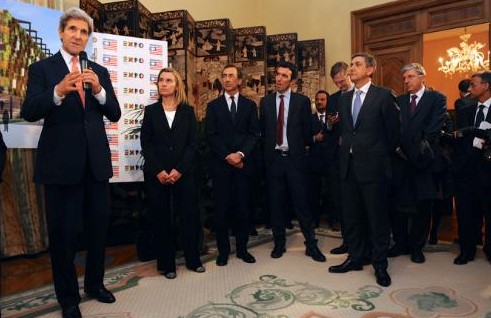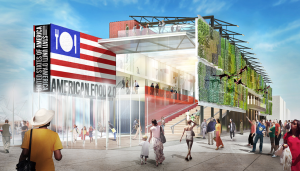
I hope people will come away feeling that the United States is thoughtfully and intelligently engaged in important issues of food around the world. I hope they’ll feel that the food scene in the US is far more interesting and dynamic than they’d imagined. Mostly, I hope people from around the world will see Americans as diverse, innovative, thoughtful, and worthy of sharing a meal together. – Tom Hennes of Thinc Design, exhibit designer for the USA Pavilion at Milan Expo 2015
This article, originally published in December 2014, is part of “Tales from the Expo” – an InPark Magazine online book written by James Ogul and edited by Judith Rubin.
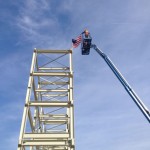
[dropcap color=”#888″ type=”square”]I[/dropcap]t is Italy’s turn to host a world’s fair. Milan Expo 2015, a registered exposition approved by the Bureau of International Expositions (BIE), will run May 1 – October 31, 2015. Projected attendance is 20 million. That doesn’t match the 70 million visits boasted by Shanghai Expo 2010, largest international exposition in history, but Milan’s projections are very good – considering that Hannover Expo 2000, the most recent comparable world’s fair in Europe, drew 18 million visits. (The BIE oversees two types of world expos: Registered and Recognized. Registered events are larger and of 6 months’ duration, comparable to what used to be known as Universal expos. At registered expos, most exhibitors design and build their own pavilions. Recognized events are smaller and of 3 months’ duration, and exhibitors occupy leased space provided by the organizers.)
Photo at top: US Secretary of State John Kerry, flanked by Italian Foreign Minister Federica Mogherini and leaders of US companies doing business in Italy, highlights the USA Pavilion at the Milan Expo 2015 during an appearance in Rome, Italy, on March 27, 2014. (State Department Photo)
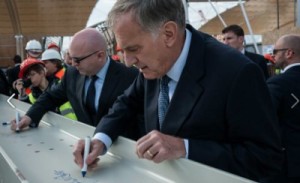
The theme of the Milan expo, “Feeding the Planet, Energy for Life,” will unite 144 countries, three international organizations, 13 non-governmental organizations and three corporate participants – in a celebration of food and the challenges, opportunities and sustainability issues of our global food system. At this writing, participants are in the midst of constructing their pavilions (click here to see an aerial video). That includes the United States which recently had its topping out ceremony, commemorating that the steel girder structure of the USA Pavilion under construction had achieved its full height of 12 meters. (Click to see story and video of the USAP groundbreaking.)
The Team
On December 1, 2014, Secretary Kerry introduced Doug Hickey, appointed to serve in the role of Commissioner General (CG) for the USA Pavilion at Milan. Hickey most recently served as president and CEO of BinWise Inc., a leading provider of analytics to premier restaurant, hotel and entertainment groups around the world. He also has more than 20 years of operational experience holding senior-level positions in the telecom, Internet and technology sectors.
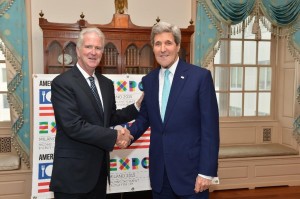
Commissioner General Hickey will have the responsibility of overseeing a massive USA Pavilion of more than 44,000 square feet. Featuring a fully-functioning vertical farm, the Pavilion – designed by celebrated architect James Biber – will showcase America’s rich agricultural history and innovation-driven successes with programs and events ranging from interactive exhibits and tastings to salons, workshops and more.
The Friends of the USA Pavilion Milano 2015, a 501(c)(3) nonprofit organization, was selected by the US Department of State to design, build and operate the US presence at the expo [click here for an article detailing the unique public-private process by which the US creates its expo pavilions]. “Friends” is a collaboration between the James Beard Foundation (JBF) and the International Culinary Center (ICC), in association with the American Chamber of Commerce in Italy.

Planning, building and operating a US Pavilion at a world’s fair is a major endeavor requiring a strong team. The pavilion’s management and program are directed by President Dorothy Hamilton (founder and CEO of ICC), CEO Charlie Faas, and Chief Creative Officer Mitchell Davis (executive vice president of JBF). They are joined by Jerry Giaquinta as Chief Communications Officer and senior adviser to the USA Pavilion. Giaquinta is a business professor at the University of Southern California (USC), and a strategic marketing and operations consultant to Fortune 100 companies.
Faas praised the team’s qualifications: “The JBF and the ICC are two highly respected organizations that have been educating and promoting America’s culinary leaders for decades. Dorothy Hamilton is one of the most influential forces shaping the American culinary landscape today. Mitchell Davis is a well-known cookbook author, food journalist and scholar. Giaquinta was the director of cultural programs for the USA Pavilion at Expo 2005 Aichi in Japan.
Faas also acknowledged Nussli Construction for quality work on the Pavilion and Andrea Grassi from GenusLoci Architecture in Milano, the local architect of record.
USC will coordinate the Student Ambassador Program for which 120 American college students will be selected to act as escorts and docents. (Click here for an article about Student Ambassadors at US expo pavilions.) New York-based Thinc Design has been selected to design the pavilion’s exhibits.
The $60 million USA Pavilion is being funded entirely through the generosity of corporations, organizations, universities and individuals. Current partners include Microsoft, Boeing, Nussli, GE, Brand USA, Uvet, DuPont, illy, 3M, McKinsey & Company and Fleishman-Hillard. US Ambassador to Italy John Phillips stated, “We rely on public-private partnerships to manage the American participation here. I am proud of this approach. We are grateful to the companies who have already made generous contributions towards the success of this Pavilion, and look forward to welcoming more sponsors, as we continue to put together an incredible team. We look forward to opening the doors of the USA Pavilion to you, and to millions of others.”
Food 2.0
The USA Pavilion at Milan 2015 has taken as its theme, ‘American Food 2.0: United to Feed the Planet.’ Charlie Faas said, “The USA Pavilion will tell America’s unique food story. We’ll explore topics including food security and policy, international relations, science and technology, nutrition and health, and culinary culture. We’ll also work to create a global conversation about the challenges of feeding the planet.”
As with all USA Pavilions there are challenges to meet in development and operations. Faas said, “We’re looking forward to not only meeting – but exceeding – visitors’ expectations. America has a rich and exciting food story – one of innovation, diversity and entrepreneurship – and we’re committed to tackling food-system challenges with the global community. If people leave the USA Pavilion feeling energized and educated, we’ll have done our jobs.”
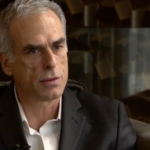
Thinc talk
“Exhibitions are wonderful places for people to build relationships with new ideas, with the familiar, and with each other,” said Tom Hennes, principal at Thinc Design. “People should encounter ideas in the exhibits that are familiar to them, and this will give them some confidence to dig deeper into the experience. If we do our job well, they’ll also be willing to encounter ideas that are new to them, enabling them to see the world through other eyes and form a fuller conception of it. That’s the real educative heart of exhibitions – giving people tools for growing new views and understandings.”
Hennes continued, “The Expo itself is focused on food – and in particular, on food security and the challenge of feeding nine billion people around the world by 2050. The USA Pavilion will offer an abundant view of that future, built out of a diversity of approaches and solutions. Within that, our two exhibition floors have related but distinct themes. The upper level – which we call the ‘Boardwalk’ level because it utilizes planks salvaged from the Coney Island boardwalk – will show ‘Abundance Through Diversity’: how different food cultures in America – farmers, policymakers, chefs, nutrition experts, researchers, and business – each contribute to global food security. The ground floor experience, ‘The Great American Foodscape,’ will look at the spectacular diversity of food in America and how it’s expanding and developing today.”
Language barriers must be addressed when speaking to the global audience of a world expo. “While storytelling is critical, and words are part of that, much can be told through cinematography and animation,” said Hennes. “One of the most important things to do in a pavilion is to communicate visually and experientially. So we stress visual and non-language auditory elements. That said, we have found in the past that a high percentage of Expo visitors speak either the native language of the host country or English. For that reason, the major graphic elements will be in Italian and English. We’re careful to avoid language that is too technical, complex, or idiomatic.”
Student Ambassadors also play a vital role in bridging language gaps. These American college and university students, selected through a competitive application process, collectively speak a wide range of languages and are there expressly to interact with visitors.
Farm & Foodscape
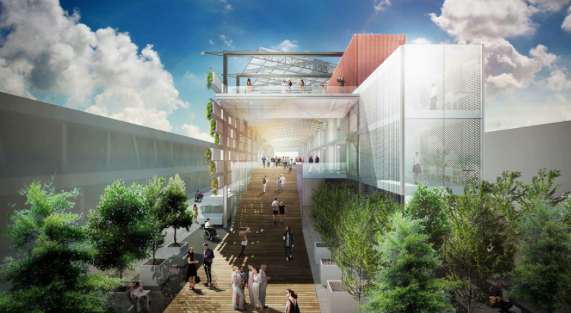
The huge, vertical farm at the USA Pavilion will be one of its signature elements. “The vertical farm will be producing crops throughout the run of the Expo,” said Hennes. “We’ll be using sections of plantings in the exhibition as well, to bring the smells and tactile sensation of living crop plants into an intimate relationship with Pavilion users. We will be utilizing an extremely high-resolution LED display for an innovative interactive game in the center of the Boardwalk level exhibits.” This is excellent continuity for the US which featured a rooftop garden in its pavilion at Shanghai Expo 2010 and addressed urban community gardening in its main show, ‘The Garden,’ in keeping with Shanghai’s ‘Better City, Better Life’ theme.
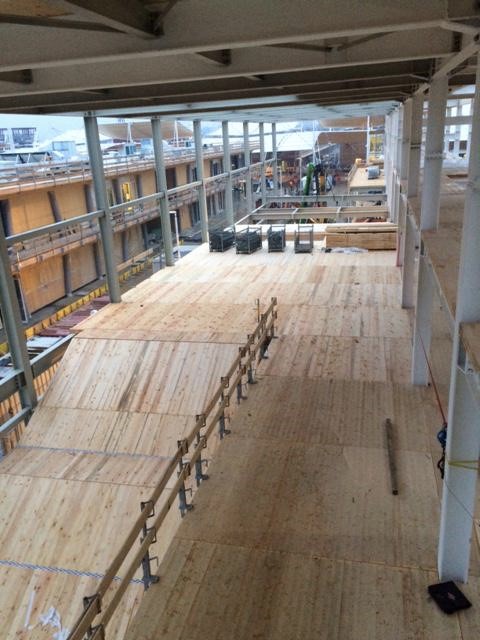
On the ground floor, ‘The Great American Foodscape’ will deliver an immersive, walk-through environment via projection mapping on a variety of surfaces and planes. Some of the interest and surprise for the visitor will come from the visual ambiguity between what is physical and what is digital.
Asked about this project’s major design challenges, Hennes indicated two: one related to process and the other to the Expo experience itself. “The first is that an Expo pavilion is always challenged by time – it’s an enormous undertaking that is lightning-fast by exhibition and production standards. This also makes them fun to do and imbues them with a wonderful kind of energy that you don’t see in many other kinds of exhibition. At the same time, it requires a large, diverse team of people who are dedicated, professional, and immensely capable. We’re very fortunate to have such a team throughout the project.”
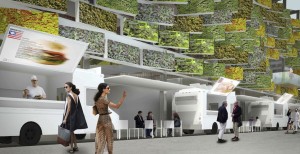
The other challenge is also common to most Pavilions: “The need to tell a coherent story to millions of people moving quickly through the Expo in a way that is fun and exciting in the moment, and lasting in memory,” said Hennes. “We have to make choices about what parts of the global story of food security and the national story of American food to tell and how to distill the story into visual, tactile, and auditory experiences that will engage people in the very short span of a visit. At the same time, we have to keep people moving through the Pavilion in order to accommodate the anticipated crowds. The United States has a really good story to tell, and we want to do it justice.”

Sponsors
US Pavilions are paid for through the generosity of private sector corporations in a partnership arrangement with the US Department of State. According to Hennes, there will be no dedicated sponsor display area as there was at Shanghai 2010, but rather a range of options for sponsor visibility. “We’re providing a variety of platforms that invite sponsors to participate in the food conversation at the Pavilion,” said Hennes. “Because many of our sponsors have deep expertise in areas of food, they are an integral part of some of our stories in the exhibits. We have also created a large multimedia display area which we call ‘American Perspectives’ that poses a wide range of questions about food and food security, featuring answers and ideas from thought leaders, including sponsors.”

Additionally, many sponsors are providing in-kind donations of technology that will be featured in the USA Pavilion. There are screens at the rooftop level and in the queue area that will carry specific messages from sponsors. And sponsors will have the privilege of access to meeting and hospitality spaces within the pavilion during the course of the Expo.


